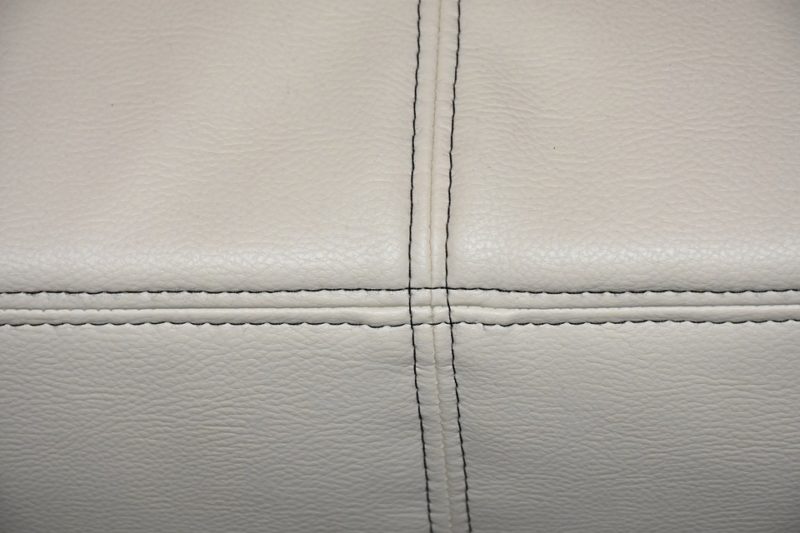Those who want to know how to patch leather sofa at home only need these two steps! We will talk about using a leather repair kit to patch up a couch and what substitutes you can use. Furthermore, we discussed other tips to restore your couch safely.
You can also read our tutorial on repairing a tear in a leather sofa, which includes patching the damage on the couch and how you can conceal it smoothly to make the repair not obvious. But if your leather sofa has various damages from deep to shallow cracks, we have a complete leather sofa repair guide you can check out.

How To Patch Leather Sofa Yourself
Step 1. Prepare the patch and insert it in the damaged area
- The most recommended way to patch a damaged leather couch is with a leather repair kit
- A leather repair kit includes a substrate patch that will become a layer underneath the damage to strengthen your repair
- You can also use other materials if you don’t have a leather repair kit
- Any material that is durable and flexible would make a good substrate patch alternative
- You can use vinyl or even a leather fabric as patch
- Place the material over the tear you want to patch on the sofa to determine the size you’ll need
- Cut the needed size but allocate a bit of allowance to make its placement easier
- Round the corners of the patch, so it wouldn’t crease when you insert it in the leather sofa
- Insert the patch underneath the damaged area using tweezers and smoothen it with any small and blunt object that can reach its edges
Step 2. Glue the patch in place
- Check if the patch has successfully covered the damaged part of the leather sofa
- Glue the material onto the couch while making sure it doesn’t crease
- Use a toothpick with leather glue on its end to reach underneath the leather
- Press the leather onto the new substrate until the tear or crack are fixed
- Wipe any glue that would ooze
- Allow the glue to dry and place a bit of pressure on the repaired area with a heavy item like a book
- Check the label on the glue to know how long you will wait for it to finish drying or if the brand has tips to hasten the drying process
- If needed, color the patched area to blend it with the rest of the leather sofa
How Do You Fill Holes In Leather?
Patching a leather sofa is only useful for cuts and tears that are not too deep. If the furniture is damaged deeper, you will need to fill the gap with a leather filler.
- Clean the damaged part of the sofa to ensure that the filler will adhere successfully
- Trim and remove the frayed parts on the edge of the hole so they won’t affect the smoothness of the filler
- Spread the filler on the damaged part of the sofa evenly and remove the excess
- The filler should be flush on the hole, and sofa surface should be smooth
- Wait for the leather filler to dry according to the product’s instructions
- Once done, check the repaired area if it feels even and strong
- Blend the filled area of the leather sofa to make it unnoticeable
- Start painting the edges to check if it’s the same shade before proceeding
- Add texture if needed and apply a leather finish to strengthen your repair and improve the look of the leather sofa
How Do You Rehydrate Leather?
Hydrating and conditioning leather with the right leather-formulated products is vital to strengthen and keep the furniture looking good as new. Since genuine leather comes from animal hide, it should constantly be hydrated to prevent issues like cracking. However, refrain from using everyday household items such as vinegar or olive oil because they might damage the material, regardless if they are famous for DIY recommendations.
- Remove all the items on the leather couch and clean it with a soft cloth and leather cleaner
- Let the leather dry and test the conditioner first on a small portion to find out if it’s compatible with your material
- Wait for an hour to check for reactions before using the leather conditioner on the entire furniture
- Apply the leather conditioner according to instructions until you covered every area
- Leather usually darkens when moisturized
- Air-dry the leather overnight to let it absorb the product
- Wipe off the residue to reveal a hydrated, vibrant, and smooth leather
What Home Remedy Can I Use To Restore Leather?
Leather experts won’t recommend DIY solutions to restore or even clean leather. While everyday household items like white vinegar, lemon juice, baking soda, olive oil, shoe polish, and petroleum jelly are popular for DIY leather restoration, they might do more harm than good. You can always test a small portion of the leather with the product, but it’s best that you only use specially-formulated leather solutions.
Conclusion
Do not panic if you notice a tear or cut on your leather couch. To recap this quick and easy tutorial on how to patch leather sofa at home, you can use a substrate patch on a leather repair kit or even vinyl and leather. Cut the correct size patch to glue on the couch, and you’re done.
For other issues on leather that don’t need patching, check this article on how to repair cat scratches on the leather sofa.
